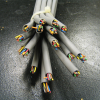Looking to make the switch
Hi everyone, looking to make the switch from windows. I’m reasonably technically apt but not a programmer by any means. I’ve been doing some homework on which distro I would like to use and pop_os kinda feels like the right direction. I’m running an Nvidia 3060TI on a Ryzen 5600 chip set on an Asus tuf motherboard. Any other distros I should be looking at, and does somebody have a link for a comprehensive guide to installing? I’m looking to continue running windows on the side until such a time as I am comfortable enough with linux that I don’t need it.








Add comment